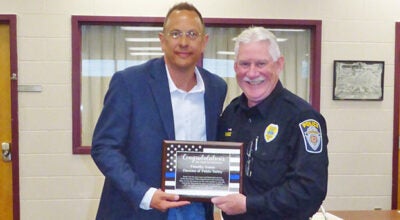Fernwood director shares stories of the floral field
Published 8:41 am Monday, February 10, 2020
BUCHANAN — Under the bolded names of leaders in the world of plants at the Sims Education Center, Fernwood executive director Carol Line shared the accomplishments of women in realm of plants in southwest Michigan and across the globe.
Her presentation, “Plant Woman,” was hosted at 1 p.m. Saturday to a crowd of about two dozen people at Fernwood Botanical Garden and Nature Preserve, 13988 Range Line Road, Buchanan.
The event kicked off a 13-day celebration of the United Nations’ International Day of Women and Girls in Science on Feb. 11.
Much like the international day itself, Fernwood’s mission with the nearly two-week celebration was to celebrate, educate and inspire people about science and the women in it.
“We want to celebrate women in STEM,” said Elaine Rowland, Fernwood’s director of development and external relations. “We want to honor their legacy, and then we want young women to pursue a career in science. We can do that by raising awareness and sharing other women’s stories.”
Fernwood put an emphasis on plants for its celebration, Rowland said, a theme heavily evident in Line’s presentation.
It was not the first time Line put on the presentation to celebrate powerhouses of the plant world. She gave the same presentation last March at the Chicago Flower and Garden Show.
Line chose the phrase “plant women” to highlight the various fields in which women have made great strides. While many scientists were noted, so too were activists, authors, illustrators, landscape architects, horticulturists and educators.
For instance, Line said former First Lady Michelle Obama could be considered a plant woman because of her work in children’s nutrition and garden education.
So, too, could home-life entrepreneur and personality Martha Stewart, whom she said bridged the gap between the scientific community and those that loved nature, crafting and art.
Line herself is a plant woman. In addition to master’s degrees in library science and plant science, she also has a bachelor’s degree in horticulture from Purdue University.
She studied under professor Harrison Flint. Many of his pupils, herself included, became leaders in botanical gardens across the country. Many were highlighted in Line’s presentation.
Line placed an emphasis on women who made impacts in their respective plant communities, not just those who were known nationally or internationally.
“I think it’s important to know that we may be able to look at someone locally doing something, and then to know someone on the other side of the globe is doing similar work,” Line said. “That sort of solidifies the importance of plant science and the work that we’re doing.”
Many people Line spoke of had ties to Fernwood, whether as founders, neighbors, interns, staff, volunteers or contracted workers.
Local plant women ranged from local organic farmers to Buchanan Tree Friends, a group working to increase the tree population in the city.
It also included Amanda Cinco-Hoyt, Lauren Mathieson and Michelle McCoskey, of Color Wheel. The Detroit natural dye collective will visit to Fernwood this summer to dye garments from plants found in the botanical garden.
When they come, the trio will recreate a scene that played out frequently shortly after Fernwood’s property was purchased by Kay Boydston and her husband, Walter. Boydston also died fabrics from plants on the property.
Regardless or region and role, Line said each woman was instrumental in the flourishing communities they helped blossom.
While some came from wealthy backgrounds or families of scientists, many had challenges in their careers because of their gender.
For instance, landscape architect and gardener Beatrix Farrand could not pursue a landscaping degree because she was a woman. Yet, she eventually became the sole woman on the inaugural board of the American Society of Landscape Architects because of her work.
Other woman still face and see challenges today, such as researcher Kay Havens.
“Fewer women plant scientists receive grants, and the grants that they receive are less than a male counterpart,” Line said of her acquaintance’s views. “She thinks that’s not a coincidence.”
These issues, Line said, make telling plant women’s stories all the more important. By spreading the big world of plants to younger generations and showing them the work of the matriarchs in it, gender discrimination and struggles can be minimized.
That mission can be summed up with Wangai Maathai, the founder of the Green Belt Movement, a conservation- and community development-focused nonprofit in Kenya. Maathai planted 20 million trees in her country.
“She wanted to empower women. She wanted to educate women. She wanted to employ women,” Line said. “Through that movement, that was what she accomplished.”






